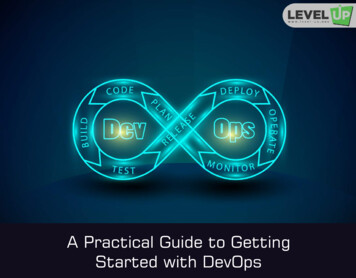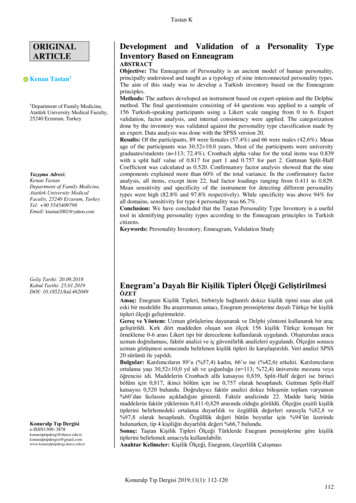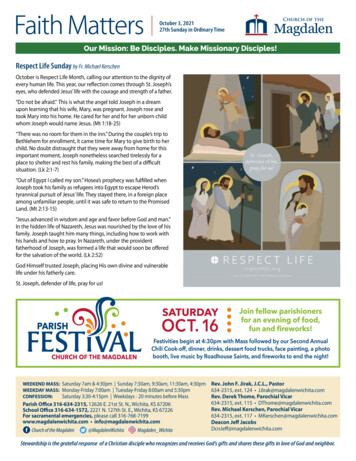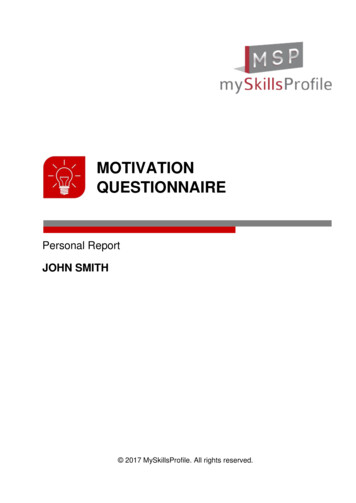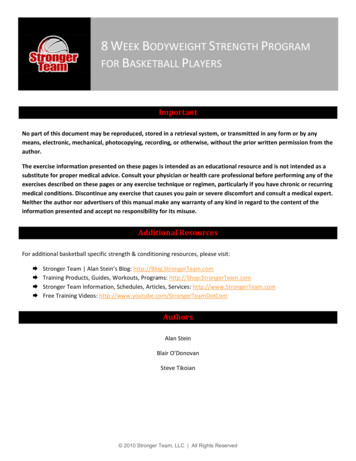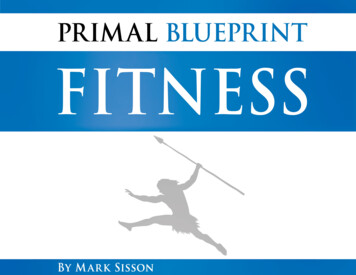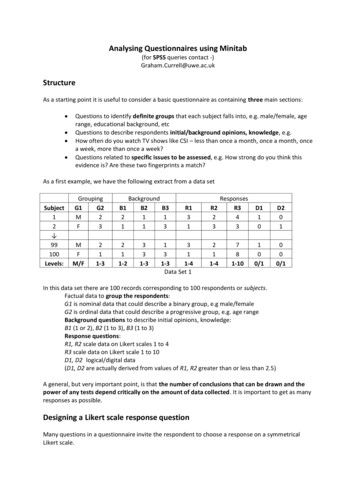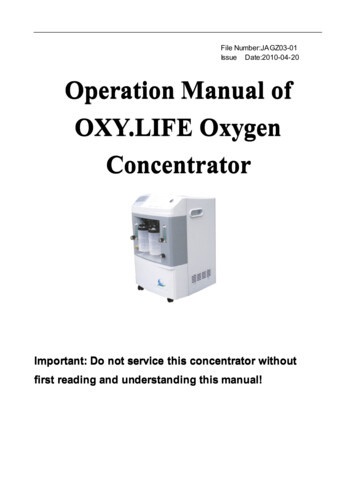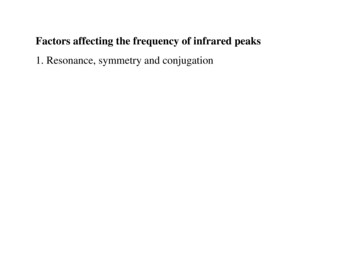
Transcription
IMPORTANTTo begin — Please save thisworkbook to your desktopor in another location.T H EH E A R T M A T HS O L U T I O N
The HeartMath Guidebook:Accessing Your Inner IntelligencebyHoward Martin MMI HeartMath LLCHeartMath, Freeze-Frame and Heart Lock-In are registered trademarks of the Institute of HeartMath, 14700West Park Avenue, Boulder Creek, CA 95006Science graphics appearing throughout this guidebook are copyrighted by the Institute of HeartMathResearch Center. Duplication of these graphics is prohibited without from the copyright holder.
Table of ContentsIntroduction . 4Heart Intelligence . 5Questions For Your Heart . 6Heart Science . 9How the Heart Communicates . 10Heart Rate Variability . 11The Heart’s Frequency Patterns . 11The Heart’s Electromagnetic Field . 12Exchanging the Heart’s Energy . 12Using the Freeze-Frame Technique . 13Questions For Your Heart . 15Freeze-Frame Worksheets . 18Some Final Notes on Freeze-Frame . 22When to Freeze-Frame . 22Finding the Neutral Zone . 22A Hint for Beginners . 22Unraveling The Mystery of Emotions . 23Questions For Your Heart . 24Energy Efficiency . 27Your Assets Worksheet . 28Energy Deficits Worksheet . 30Care vs. Overcare . 32Care/Overcare Worksheet . 33Appreciation . 34Appreciation Worksheet . 35Love . 36Questions for Your Heart . 37The Dimensional Shift . 39Questions For Your Heart . 40Heart Lock-In . 42Heart Lock-In Worksheet . 43Glossary . 47More on Heartmath . 48T H EH E A R T M A T HS O L U T I O N3
IntroductionListen to your heart Follow your heart Your heart knows best.Simple words often repeated, although too seldom thoroughly embraced. Profound wordsbrimming with promise, too rarely taken fully — no pun intended — to heart.And that’s a shame. Because it could make all the difference in the world — to yourhealth, your happiness, the heights of your ultimate satisfaction and success, even theholistic well being of the entire planet.For, by accessing the magnificent, intelligent power of your own heart’s intelligence, youcan eliminate stress, facilitate change, infuse yourself and others with a renewed sense ofhope and empower yourself to live life to its fullest potential.As individuals, we all share a desire to be in contact with what is most deep and true inourselves. Yet we know that we cannot just think our way to that goal. Our minds ontheir own are not enough. To be a complete human being requires something more. Ittakes heart. It takes your heart’s intelligence. It takes HeartMath.Created by Doc Childre — an author, researcher and consultant to leaders in business, science and medicine — HeartMath is a system for unlocking the heart’s innate intelligence.It is a new psychology and physiology based on the combination of the heart’s power andintelligence. It is an innovative, resourceful approach to healthy and fulfilling living.At the core of the HeartMath system is balance. As you practice these tools sincerely andconsistently, you will discover greater balance mentally, emotionally and physically. Fromthis new balance arises vitality, hope and fulfillment.In this guidebook you will find the tools needed for bringing your heart into the decisionmaking process, for de-stressing your life and for opening yourself up to core emotionslike love, caring and appreciation.You will also find important questions in this guidebook, questions you will be invited toanswer. They are designed to examine the very deepest reaches of who you are. You willalso find multiple copies of several worksheets. Copies are provided here, enough to coverall exercises found in the audio program.4T H EH E A R T M A T HS O L U T I O N
It is recommended that you make additional copies of these supremely helpful worksheetsto use after you complete the program.Are you ready to reexamine your heart? To bring it into the center of your life? Torelease the concept of the heart out of its confinement in religion and philosophy and putit to work where it is needed most — in your everyday life?Let’s begin!Heart IntelligenceJust as the mind/brain is viewed as an important information-processing site, researchnow shows that the heart is one too. In fact, it has been found that the heart possesses ahigh-speed, intuitive intelligence. You’ve probably experienced it without really knowingwhat was happening. Have you ever simply “known” the right way to respond to a situation? Just “felt” the best decision you could make in a particular situation? That wasyour heart intelligence at work.How does heart intelligence work? Research indicates that the heart’s electrical fieldreceives information and transmits it to the brain. When your mind is in phase or in syncwith your heart, the results are efficient, productive thoughts and actions. Combiningintuition with the heart’s special qualities — including love, care, understanding and sincerity — the heart blends seamlessly with the mind’s knowledge and ignites its higherfunctional capacities.The Heart’s IntelligenceIn other words, your mind figures thingsout, but it is your heart that truly understands. a self-initiated processHeart intelligence is the flow of awarenessand insights once the mind and emotions arebrought into balance and coherence. It is a a direct, intuitive knowingmajor shift beyond ordinary thinking. Itgives a wider understanding than is possible thoughts and emotions beneficialwith just the deductive process of linearfor ourselves and othersthinking. But social programming and habitprobably have trained you to live in yourmind, where your thinking is caught up in a process that too often results in insecurity, worry,resentment and frustration. an intelligent flow of insightand awarenessT H EH E A R T M A T HS O L U T I O N5
You experience heart intelligence as direct, intuitive knowing that manifests in thoughtsand emotions beneficial to yourself and others. Your body works more efficiently becausethe choices you make are in sync with the values you hold so deeply. When you use thisintelligence, life just works.Questions for Your HeartAnswer the following questions. Be as honest and introspective as you can. There are noright or wrong answers.1. Recall a time when you followed your heart, when you relied on the intuitive intelligence it provided. What was the situation? What was the result? Why did you rely onyour intuition in this instance? Describe how the intuition felt.2. Recall a time when you did not follow your heart, when you ignored the intuitiveintelligence it provided. What was the situation? What was the result? Why did youignore your intuition in this instance?6T H EH E A R T M A T HS O L U T I O N
3. Take a moment to give voice to your negative “chatter,” those comments and worriesyou hear in your mind that can hold you back and put you down.4. What other energy-draining thought patterns do you find yourself repeating in your life?5. How have these negative thoughts been translated into actions or decisions you later regretted?T H EH E A R T M A T HS O L U T I O N7
1. What are you most deeply held values? Have you ever been tempted by negativethoughts to betray those values?2.What do you want in your life? What are your life’s goals, professionally, personally,financially and spiritually?8T H EH E A R T M A T HS O L U T I O N
Heart SciencePerception is everything. Your perception of any situation triggers a mental and an emotional response, each of which causes electrical changes in the nervous system, heart andbrain. Those electrical changes affect your heart rate, blood pressure, hormonal andimmune responses, which in turn influence health and aging.Depending on whether your perception of a situation is negative or positive, thesechanges result in increased physical energy or a depletion of it, mental and emotionalclarity or the lack of it and increased or decreased communication abilities. As you learnto lead a heart-empowered life, you enjoy clearer, balanced perceptions, as well as a morepositive effects on your health, relationships, creativity and well being.Stress is our perception of anevent; not the event itself.T H EH E A R T M A T HS O L U T I O N9
How the Heart CommunicatesScientists have discovered that the heart communicates in four ways: neurologically(brain and heart), biophysically (pulse), biochemically (hormones) and energetically (electromagnetically).The follow graphic illustrates the various components of the body’s amazing neurologicalheart/brain communication system.1 0T H EH E A R T M A T HS O L U T I O N
Heart Rate VariabilityYour heart rate actually changes with each and every beat. These changes are influencedby almost any stimulus the brain and mind can process and send through the nervoussystem, including your perceptions and emotions.Heart Rate Variability (HRV) is the measurement of the beat-to-beat changes in heart rateas the hearts speeds up or slows down. Thefollowing chart illustrates the changes in HRVin just 2.5 seconds.Positive heart-based feelings generate smoothand harmonious HRV rhythms, which areconsider indicators of cardiovascular efficiency and nervous system balance. However, thetypical HRV pattern of someone feeling frustrated or edgy looks irregular and disordered, illustrating a condition called cortical inhibition, in which thinking becomes less clear. It is a sign of possible hypertension, animportant risk factor in heart disease.The Heart’s Frequency PatternsResearch has discovered a “little brain in theheart,” a heart-based information processingsystem from which it can send information tothe cortical area of the brain, the site wherehigher cognitive functions take place. Therelationship also runs in the other direction;the brain — and the thoughts and emotions itproduces — affect the electrical patterns ofthe heart.Scientists can now observe the effects of emotions on the frequency pattern of the ECG, the electrical signal produced by the heart. Inone study researchers found that frustration produced a disordered frequency pattern,called an “incoherent spectrum.” A positive emotion like appreciation, produced a lovely,highly ordered frequency called a “coherent spectrum.” (In the universe of heart intelligence, coherence is an alignment of the heart’s frequencies that causes an increase in power.)T H EH E A R T M A T HS O L U T I O N1 1
The following chart demonstrates the affects of positive and negative emotions on theheart’s frequency patterns.The Heart’s Electromagnetic FieldThe heart’s electrical field also operates like aradio receiving and transmitting stations that sendinformation beyond the physical body. In fact, theheart’s electromagnetic filed has been measured 10feet away from the body. It surrounds the body ina 360-degree sphere. This field should not be mistaken for an aura, for it is a highly measurableelectromagnetic frequency. Your body is literallybroadcasting electrical frequencies from the heart24 hours a day for your entire life.The following illustration shows the electromagnetic field surrounding a human body.Exchanging the Heart’s EnergyThere is also a fascinating new method ofmeasuring the electrical exchange of heartenergy between people when they are in touchor in close proximity. Research has produceddata showing that one person’s heartbeat canbe measured in the brain waves of anotherperson when they touch. They call it “TheElectricity of Touch.”The following chart illustrates the Electricityof Touch, measuring the electrical exchange ofpeople in contact and holding hands.1 2T H EH E A R T M A T HS O L U T I O N
Using the Freeze-Frame TechniqueWhen you use the Freeze-Frame Technique, you create a window of opportunity that allowsyou to access your intuitive intelligence. By using the heart to shift perceptions in the brain,your mind and emotions become calm and you activate a positive feeling that send improvedbioelectrical and neurochemical information to the higher perceptual centers of the brain.You synchronize your entire system, bringing it into a state of entrainment, in which theheart and mind work together, so you can operate a peak performance.On a practical level, visualize using the Freeze-Frame Technique as pushing the pausebutton on your internal VCR. You can actually stop the movie of your life and reorderand rethink its reality. You can use this technique any time, anywhere — whenever youwant to stop stress in its track and quickly access your heart’s intelligence.Freeze-Frame consists of five steps:Step 1: Recognize that you a experiencing a stressful moment.Take a time out and freeze-frame it. Consider this a strategy similar to a team strugglingon the basketball court to regroup. Don’t beat yourself up for feeling stress. The key hereis to recognize it, as well as the need to refocus it.Step 2: Make a sincere effort to shift your attention away from your racing mind.Move your focus to the area around your heart. Pretend you’re breathing through yourheart, keeping the focus there for at least 10 seconds. This shift of focus removes energyyour brain-based perception of the problem.Step 3: Recall a positive, fun feeling or time you’ve had in life.There are no restrictions on what you can think about. It can be anything. Whatever it is,remember how it felt. Remembering the feeling will connect you with your heart. Thefeeling is key; this is not about visualization.T H EH E A R T M A T HS O L U T I O N1 3
Step 4: Ask your heart what would be a more efficient response to yourcurrent situation.To ask your heart this question sincerely minimizes stress and brings wholeness. It allowsyour own intuition, common sense and sincerity to become more active and available.Step 5: Listen to what your heart sayis the answer to your question.“Now here is my secret, avery simple secret: it is onlywith the heart that one cansee rightly. What is essentialis invisible to the eye.”Just sit quietly, stay in your heart andwait. The result of this can be as if yourheart talks to you, with a voice quite different than thoughts emanating fromyour brain.Freeze-Frame not only helps you becomeaware of your freedom to choose, it puts itSaint Exporyright in your face where you can’t ignore itor brush it aside. You become so completely aware that at any moment you can choose to go to your heart and change a stressfulor disordered or incoherent feeling. And when you choose a new perspective, you actuallyreedit the movie of your life. It’s like bringing the walk on the beach to you, even if you’rerushing to get somewhere, struggling to meet a dead line or facing a tense moment in a relationship.1 4T H EH E A R T M A T HS O L U T I O N
Questions for Your HeartAnswer the following questions. Be as honest and introspective as you can. There are noright or wrong answers.1. What are you stress triggers? In what situations or with which people are you likely tofind yourself feeling stressed or tense?2. How do you react to stress? What are the clues that tell you that you are respondingnegatively to a stressful situation or person? Are you good about recognizing these clues?T H EH E A R T M A T HS O L U T I O N1 5
3. What do you do now to reduce stress? How effective is it?1. Take a few moments to practice focusing on your heart and breathing through yourheart, as required by the Freeze-Frame Technique. What was your experience? Was iteasy? Difficult? Why?2.List past positive experiences that you might be able to use in Step 3 of Freeze-Frame.1 6T H EH E A R T M A T HS O L U T I O N
3. Think of three recent situations in which you experienced stress. Use the space belowto phrase the questions you might have asked your heart had you used Freeze-Framein those situations.4. How willing are you to trust your heart? If your heart gave you the answer to animportant question, would you believe it? At this moment are you able to follow yourheart’s advice? How might you prepare yourself to become even more trusting?On the following four pages, you will find copies of the Freeze-Frame Worksheet, designedto lead you through this important technique. Use copies of this worksheet to complete theFreeze-Frame exercises included throughout the audio program. However, it is best ifbefore using all them, that you make additional copies for use after you have completedthe program.T H EH E A R T M A T HS O L U T I O N1 7
Freeze-Frame Worksheet1) Shift 2) Activate 3) AskSituation:Head Reaction:FREEZE-FRAMEHeart Intelligence Response:1 8T H EH E A R T M A T HS O L U T I O N
Freeze-Frame Worksheet1) Shift 2) Activate 3) AskSituation:Head Reaction:FREEZE-FRAMEHeart Intelligence Response:T H EH E A R T M A T HS O L U T I O N1 9
Freeze-Frame Worksheet1) Shift 2) Activate 3) AskSituation:Head Reaction:FREEZE-FRAMEHeart Intelligence Response:2 0T H EH E A R T M A T HS O L U T I O N
Freeze-Frame Worksheet1) Shift 2) Activate 3) AskSituation:Head Reaction:FREEZE-FRAMEHeart Intelligence Response:T H EH E A R T M A T HS O L U T I O N2 1
Some Final Notes on Freeze-FrameWhen to Freeze-FrameWhen is the best time to Freeze-Frame? The very best time is before you need it. You canbecome so attuned to yourself and your reactions that you’ll recognize the very firstmoment you begin to drift toward stress and discomfort. That is the time to seek yourheart’s counsel.Another ideal time, of course, is when you feel negative feelings. Whenever anxiety, sadness,unforgiveness, resentment and stress have a hold of you, it is definitely time to Freeze-Frame.And, finally, any time you want to move yourself toward the creation of loving feelingsor feelings of appreciation, creativity or caring is the time to Freeze Frame.Finding the Neutral ZoneSometimes during emotionally charged situations, generating a heart-felt feeling seemsalmost impossible. When you face a situation like this, breathe through the heart andhold Step 2 of the Freeze-Frame process. Then, with sincere intention, call on your heart’sintelligence to help you become more neutral.When you manage to reach a neutral state, your heart rhythms will soon restore theirbalance so that you can perceive new options for action, instead of mechanically reactingon impulse and paying for (and probably regretting) it later.Don’t underestimate the power of the neutral zone. It saves energy, provides a conduit forobjectivity and creates fertile ground for new insights to grow. The ability to find theneutral zone and stay there until the heart clearly reveals what to do is a sign of balancedmaturity. As you practice Freeze-Frame, you’ll leave the weave heart intelligence systematically into your daily life.A Hint for BeginnersWhen you first learn Freeze-Frame, it is good to close your eyes. This helps you increasethe connection between your head and heart. After some practice, you’ll be able to makethis shift from the head to the heart right in the middle of daily activities without closingyour eyes — in meetings, before important phone calls or even in the heat of an emotionally charged situation.2 2T H EH E A R T M A T HS O L U T I O N
The Mystery of EmotionsIntricately complex and always in flux, your emotions can bring you a satisfying richnessand a deep sense of being fully engaged in the world around you. However, if they aren’tmanaged in a healthy way, they can also supply a steady diet of upheaval, uncertaintyand incoherence.Your emotional circuitry is uniquely your own. Imprinted into your memory by a lifetimeof experiences, any emotional response can become quite predictable given a particularexternal stimulus. In fact, an emotional response is often not a reaction to a new situation or event. It is an automatic replication, a replay, of a similar response from yourpast. In other words, your emotional responses quickly can become habits. This is calledthe Cascade Effect.When incoherent emotional patterns — like anger, worry, guilt or frustration — arerepeated constantly, they transform into habits, or “presets”. As these habits are reinforced, they become traits that continue to take you further away from more pleasurableemotions. They put a negative slant on your perceptions, drain away your energy and ageyou prematurely.Because your emotions work faster than your mind, managing them can become a daunting challenge. But it can be done. To master this challenge — and your emotions — youmust bring your heart into the process, aligning it with your head to bring a consistencyand coherence to the broad range of feelings accessible by every human. Gain freedomfrom your emotional presets by infusing them with your heart intelligence.Create changes in your brain that help you manage your emotions by bringing your heartinto the process. When you experience an unpleasant or negative emotion, always try todiscover what preset has caused it. Then try to release some of the emotional significanceyou’re attached to that issue by focusing your attention on the area between your heartand solar plexus, or your chest and stomach. Breathe through this area, making an effortto adopt an attitude of peace, an exercise called attitudinal breathing that can bring youremotions back into balance.T H EH E A R T M A T HS O L U T I O N2 3
Questions for Your HeartAnswer the following questions. Be as honest and introspective as you can. There are noright or wrong answers.1. Discuss your relationship with your emotions. Do you embrace them? Reveal themwith ease? Shy away from expressing them?2. Are some emotions easier for you to express than others are? Which ones? Why doyou believe you have less trouble with them?2 4T H EH E A R T M A T HS O L U T I O N
3. Are there emotions you particularly try to avoid? Which ones? Why do you avoid them?4. Think about the emotions you find easiest to express. What lessons, if any, can youlearn from them and your expression of them that you can begin to apply to thoseemotions with which you have more difficulty?T H EH E A R T M A T HS O L U T I O N2 5
5. Are there situations in which and people to whom you find it easier to express youremotions? What situations? Who? Why do you believe it is easier in these situations orwith these people? What lessons can you learn from them to extend to other, more difficult situations/people?6. Which, if any, negative emotional patterns do you detect in yourself? What are theirtriggers? Are their clues to recognizing this “Cascade Effect” in yourself?2 6T H EH E A R T M A T HS O L U T I O N
Energy EfficiencyFor anything to move or change, energy is required. When you understand how energyworks in your mental, emotional and physical systems, you can ensure that your energyworks for you rather than against you. Creating the life you want and breaking throughold patterns into new states of awareness require the accumulation of more energy. Whenyour energy accumulators are full, you have more power to accomplish our goals, deflectstress, eliminate self-defeating behaviors and increase awareness.The way in which you accumulate and spend your personal energy reserves (your lifeforce) is the key factor determining the quality of your life. Mental and emotional expenditures dictate your overall energy level, as well as your health and well-being to a fargreater extent than most people realize.Events that add energy and efficiency to your life are called “assets.” A day filled withassets can energize you. We all have assets in our lives, although sometimes we fail tonotice or appreciate them. While sometimes these moments are rare or random, they doexist, and they should be something you strive for.On the following four pages you’ll find two worksheets on which you should recallevents, conversations and activities that occurred over the last three days. On the firstworksheet, “Your Assets,” list the events, etc. that made you feel “just right,” as if everything was in sync. Then describe those feelings or effects in your own words, so you willbe able more easily to recognize the effect in the future.On the second worksheet, “Energy Deficits,” list events, etc., that drained your energy,left you feeling incoherent. Then describe those feelings or effects in your words.Copy these worksheets before using them or use additional sheets of paper if you needmore space for these exercises.T H EH E A R T M A T HS O L U T I O N2 7
Your Assets WorksheetEventEffectEventEffectEvent2 8EffectT H EH E A R T M A T HS O L U T I O N
EventEffectEventEffectEventEffectT H EH E A R T M A T HS O L U T I O N2 9
Energy Deficits WorksheetEventEffectEventEffectEvent3 0EffectT H EH E A R T M A T HS O L U T I O N
EventEffectEventEffectEventEffectT H EH E A R T M A T HS O L U T I O N3 1
Care vs. OvercareThe heart is full of emotions that can regenerate your body and spirit. Learning the importance ofthese feelings is key to achieve a new level of emotional mastery.Positive emotions like love, care, appreciation and compassion are the “core emotions.” Thesepowerful emotions have profound effects on body, brain, intelligence and awareness. They add richtextures to your life and to the lives of others.One of the most important core emotions is care, a powerful motivator. Not only is caring one ofthe best things you can do for your health, but it feels good — whether you’re giving or receivingthe caring. Without care, life loses its luster. It produces visible effects on your body, like a bouncein your step or a gleam in your eye. Health and vitality spring from heart-based emotions like care.But you can cross a line, and care can turn into something much less positive called “overcare.” Itoccurs when your mind turns your caring intentions into a mental and emotional drain. You mightover-identify with a situation, an issue or a person. Over-identity never results in any real solutionto a problem. Even when your initial intentions are good, over-identity and overcare create thesame incoherence as any other stress.If you don’t manage overcare, it eventually leads to a lack of caring and burnout. You remain sostressed that you end up feeling, and in many cases being, ineffectual. You’ve cared
MMIHeartMathLLC trademarksoftheInsti
